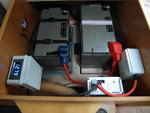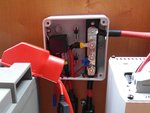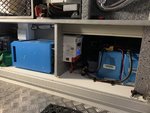xsilvergs
Free Member
- Messages
- 240
What are the two 'Coil +Diode' units? added in? not sure how they come into play?
I don't know what relies on what in terms of the existing electrics, but this circuit will disconnect the connection between J2 and Leisure Battery ....
View attachment 50825
The Coil+Diode represent the coil in a relay, in my business we would always put a diode across the relay coil, it snubs the high voltage spikes when the supply is removed from the coil.
In my circuit the Double Pole relay is doing a similar job as your Low-Power Relay and additionally enabling the B2B. This relay really isn't required in hindsight.
The Single Pole relay is doing the same as your High-Power Rely.
Relays are reliable and easily changed should they fail.
I am grateful for your circuit diagram, thank you. What software do you use to create these drawings?
I am still considering the use of a single 100 amp diode in the feed between Starter Battery and J1. There will be a small voltage drop, approximately 0.75 volts across the diode.
With the engine running the higher B2B voltage can't feed back to the SB. The fridge would get a slightly elevated voltage which may improve its efficiency. A drawback could be that the B2B sees a slight change as the fridge thermostat clicks in and out.
I would appreciate your comments on the attached circuit, there must be a flaw I haven't seen yet.



